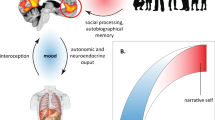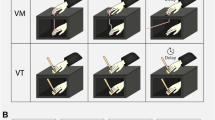Abstract
While sufferers of major depression to the present day sometimes describe their experience as “mental pain,” limited attention has been given to one of the major etiologic theories of 19th century psychiatry: melancholia as psychalgia. I illustrate the development of this theory, which arose in the context of the early phases of the application of psychophysiology to mental illness, through German, French, and English psychiatric texts from the 1830–1870s. As clinical pathological correlation became a dominant paradigm in early 19th medicine, nervous diseases stood out as potential exceptions, sometimes demonstrating “pain without lesions” or neuralgia. Tic Douloureux was a paradigmatic example. The first descriptions of reflex actions in the spinal cord in the early 19th century resulted in a range of theories of reflexes in brain that expanded to include “ganglia” that could react to diverse complex social and mental stimuli, and whose actions could impact key mental functions including mood. Theories of neuralgia included a constitutional predisposition and an acute physical trauma producing a hypersensitivity so that normal stimuli (e.g., touch) were misinterpreted as excruciating pain. A parallel framework was conceptualized in the brain to produce psychalgia. A predisposition combined with a mental trauma could produce hypersensitivity in key brain ganglia. This psychophysiological framework explained how normal social and introspective experiences would, in melancholic patients, be interpreted in a distorted manner, reinforcing themes of inadequacy, failure, and worthlessness, and produce a sustained mood state of intense mental pain or psychalgia. I illustrate the development of this theory, which integrated brain and mind-based perspectives on mental illness, through the writings of four major 19th alienists: Guislain, Griesinger, Maudsley, and Krafft-Ebing.
This is a preview of subscription content, access via your institution
Access options
Subscribe to this journal
Receive 12 print issues and online access
$259.00 per year
only $21.58 per issue
Buy this article
- Purchase on Springer Link
- Instant access to full article PDF
Prices may be subject to local taxes which are calculated during checkout
Similar content being viewed by others
References
James W. The varieties of religious experience. New York 1902.
Styron W. Darkness visible: A memoir of madness. New York: Random House; 1990.
Jansson Å. From Melancholia to Depression: Disordered Mood in Nineteenth-Century Psychiatry. London: Palgrave MacMillan; 2020.
Hodgkiss A. From lesion to metaphor: chronic pain in British, French and German medical writings, 1800-1914. Amsterdam: Rodopi; 2000.
Albrecht FM. A reappraisal of faculty psychology. J Hist Behav Sci. 1970;6:36–40.
Kendler KS. The impact of faculty psychology and theories of psychological causation on the origins of modern psychiatric nosology. In: Kendler KS, Parnas J, Zachar P, editors. Levels of Analysis in Psychopathology: Cross-Disciplinary Perspectives. 5th. 1st ed. Cambridge, UK: Cambridge University Press; 2020.
Kendler KS, Tabb K, Wright J. The emergence of psychiatry: 1650–1850. Am J Psychiatry. 2022;179:329–35.
Riese W. The conception of disease: its history, its versions, and its nature. New York: Philosophical Library; 1953.
Ackerknecht EH. Medicine at the Paris hospital 1794-1848. Baltimore: Johns Hopkins University Press; 1967.
Shoja MM, Tubbs RS, Loukas M, Shokouhi G, Ardalan MR. Marie-François Xavier Bichat (1771–1802) and his contributions to the foundations of pathological anatomy and modern medicine. Ann Anat-Anatomischer Anz. 2008;190:413–20.
Haslam J. Observations on insanity: with practical remarks on the disease, and an account of the morbid appearances on dissection. London: Printed for F. and C. Rivington, and sold by J. Hatchard; 1798.
Arnold T. Observations on The Nature, Kinds, Causes, and Prevention, of Insanity. Second Edition ed. London: Richard Phillips; 1806 1806.
Brown EM. French psychiatry’s initial reception of Bayle’s discovery of general paresis of the insane. Bull Hist Med. 1994;68:235–53.
Goldstein J. Console and Classify: The French Psychiatric Profession in the Nineteenth Century. New York: Cambridge University Press; 1987 1987.
Bichat X. General Anatomy, Applied to Physiology and to the Practice of Medicine. London: Shackell, Arrowsmith, Johnson’s Court; 1824.
Patel SK, Liu JK. Overview and history of trigeminal neuralgia. Neurosurg Clin. 2016;27:265–76.
Fothergill J. Of a painful affection of the face. Soc Physicians Lond: Med Observations Inquiries. 1773;5:129–42.
Clarke E, Jacyna LS. Nineteenth-century origins of neuroscientific concepts. Berkeley, Ca: Univ of California Press; 1987.
Billing A. First Principles of Medicine. Third ed. London: ROBSON, LEVEY, AND FRANKLYN.; 1838.
Leff A. Thomas Laycock and the cerebral reflex: A function arising from and pointing to the unity of nature. Hist Psychiatry. 1991;2:385–407.
Laycock T. A Treatise on the Nervous Diseases of Women; Comprising an Inquiry Into the Nature, Causes, and Treatment of Spinal and Hysterical Disorders. London: Longman, Orme, Brown, Green, and Longmans; 1840.
Guislain J. Traité sur les phrénopathies, ou doctrine nouvelle des maladies mentales. Second ed. Bruxelles: Etablissement encyclopgraphique; 1835.
Masson MM-DB. La douleur morale: historique et devenir d’un concept clinique. Annales Med-Psychologiques. 2014;172:139–45.
Guislain J. Leçons Orales sur Les Phrénopathies, ou Traitê Thêorique Et Pratique Des Maladies Mentales: Cours Donné A La Clinique Des Êtablissements D’Aliénés A Gand. Paris, & Bonn,: Gand, L. Hebbelynck, Êditeur; 1852 1852.
Laycock T. On the naming and classification of Mental Diseases and Defects. J Ment Sci. 1863;9:153–72.
Marx OM. Wilhelm Griesinger and the history of psychiatry: a reassessment. Bull Hist Med. 1972;46:519–44.
Griesinger W. Ueber psychische Reflexactionen. Arch für Physiologische Heilkd. 1843;2:76–113.
Griesinger W. Bemerkungen zur neuesten Entwicklung der allgemeinen Pathologie. Arch für Physiologische Heilkd. 1843;2:278–89.
Griesinger W. Mental Pathology and Therapeutics. London: The New Sydenham Society; 1867 1867.
Maudsley H. The Physiology and Pathology of The Mind. New York: D. Appleton and Company; 1867 1867.
Engstrom EJ, Kendler KS. Richard von Krafft-Ebing’s views on the etiology of major psychiatric illness. Psychol Med. 2013;43:1345–52.
Krafft-Ebing RV. Die Melancholie: Eine Klinische Studie. Erlangen: Verlag Von Ferdinand Enke; 1874.
Kendler KS. A pre-history of the diathesis-stress model: predisposing and exciting causes of insanity in the 19th century. Am J Psychiatry. 2020;77:576–88.
Marx OM. Nineteenth-century medical psychology: Theoretical problems in the work of Griesinger, Meynert, and Wernicke. Isis. 1970;61:355–70.
Meynert T. Psychiatry; a clinical treatise on diseases of the fore-brain based upon a study of its structure, functions, and nutrition. New York: GP Putnam’s Sons; 1885.
Alzheimer A. Beiträge zur pathologischen Anatomie der Hirnrinde und zur anatomischen Grundlage einiger Psychosen. Monatsschrift fur Psychiatr und Neurologie. 1897;2:82–119.
Lanczik M, Keil G. Carl Wernicke’s localization theory and its significance for the development of scientific psychiatry. Hist Psychiatry. 1991;2:171–80.
Dahlstrom A, Fuxe K, Olson L, Ungerstedt U. Ascending systems of catecholamine neurons from the lower brainstem. Acta Physiologica Scandinavica. 1962;62:485–6.
Dahlstrom A, Fuxe K. Evidence for the existence of monoamine-containing neurons in the central nervous system. I. Demonstration of monoamines in the cell bodies of brain stem neurons. Acta Physiol Scand Suppl. 1964;232:1.
Fuxe K, Hokfelt T, Nilsson O, Reinius S. A fluorescence and electron microscopic study on central monoamine nerve cells. Anat Rec. 1966;155:33–40.
van Rossum JM. The Significance of Dopamine-receptor blockade for the action of neuroleptic drugs. Neuropsychopharmacol Excerpta Med Found, Amst. 1967;1967:321–9.
Matthysse S. Antipsychotic drug actions—clue to neuropathology of schizophrenia. Federation Proc. 1973;32:200–5.
Schildkraut JJ. The catecholamine hypothesis of affective disorders: a review of supporting evidence. Am J Psychiatry. 1965;122:509–22.
Coppen A. The biochemistry of affective disorders. Br J Psychiatry. 1967;113:1237–64.
Kendler KS, Campbell J. Expanding the domain of the understandable in psychiatric illness: an updating of the Jaspersian framework of explanation and understanding. Psychol Med. 2014;44:1–7.
Acknowledgements
Translations from German texts are performed by Astrid Klee MS and KSK and from French texts by KSK. Joel Braslow MD and Eric Engstrom PhD provided helpful comments on preliminary versions of this essay.
Author information
Authors and Affiliations
Contributions
KSK conceptualized this essay, performed the primary research, and drafted and revised the manuscript.
Corresponding author
Ethics declarations
Competing interests
The author declares no competing interests.
Additional information
Publisher’s note Springer Nature remains neutral with regard to jurisdictional claims in published maps and institutional affiliations.
Rights and permissions
Springer Nature or its licensor (e.g. a society or other partner) holds exclusive rights to this article under a publishing agreement with the author(s) or other rightsholder(s); author self-archiving of the accepted manuscript version of this article is solely governed by the terms of such publishing agreement and applicable law.
About this article
Cite this article
Kendler, K.S. Melancholia as psychalgia: the integration of psychophysiological theory and psychopathologic observation in the mid-19th century. Mol Psychiatry 28, 230–235 (2023). https://doi.org/10.1038/s41380-022-01894-z
Received:
Revised:
Accepted:
Published:
Issue Date:
DOI: https://doi.org/10.1038/s41380-022-01894-z



